irisartinsights
141 posts
Art Insights Reviews & Interviews Follow @TalkArtInsights
Don't wanna be here? Send us removal request.
Text


Some Advantages and Obstacles to being creative and productive as older women artists, as well as what some said they feel and need to be better supported and more productive. They were shared during a first meeting of BIDDY BOOST a monthly mentoring group for older women artists in Oxfordshire. We had invited artists over fifty to join but most are in fact in their sixties and seventies. Some have been making art for decades, most in this group though came to art practice later in life, studying Fine Art at Oxford Brooke’s University. It was an opportunity for all to share often unspoken feelings and to feel the support of solidarity and identification with others.
0 notes
Text
The BIDDY BOOST meeting for artists last week was part of our series of led discussions on art practice. We explored aspects of INSPIRATION and IDENTITY. It was fascinating hearing of the artists and works that have inspired us all, Frida Khalo topped the poll ! Next month we will look to ramp up our productivity in a session themed METHOD and MAINTENANCE. All of which is leading us towards our major exhibition with associated events in the Glass Tank Gallery at Oxford Brookes next January.
0 notes
Text

Still, after many years of art practice, I am asked to explain, to justify in effect, why I give so much of my time to art, writing and curation when it doesn't generate much income and isn't it a hobby ?
When I explain that I set out to be an artist knowing that it wouldn't make me much of a living then people often look incredulous. It is apparently hard to believe that I knowingly embarked on the years of struggle I have lived through as I persisted with my art practice.
I sill believe, as I did when leaving the RCA in 1988 that I am an artist, will always be an artist and it is the most important thing in my life.
Of course I needed income, especially when raising my two children and I grafted hard to make a living doing jobs of all varieties from lecturing in art schools, the best, to call centre and cleaning work, the worst. There have been times over the years when I wished my art would bring in more money but I just didn't have an interest in making art to be sold, and even when I did I found it tedious to try to do so. I have sold drawings and prints now and again and it is a thrill to do so of course. It just isn't the reason I do it.
If my not making much money from art means that people feel more comfortable describing my practice as a hobby, it really is their problem.
1 note
·
View note
Text
THE ART OF REFLECTION
Opening and closing twice in 2020 due to the Covid pandemic lockdown, The Ashmolean Museum Oxford’s ‘Young Rembrandt’ exhibition displayed early works charting the first decade of the working life of the artist. It showed his tentative beginnings and rapid development of skill, leading to his emergence as a prolific master of painting and print-making. The exhibition was the starting point for the COU COU ‘JONG/young’ exhibition, as curator Clare Carswell invited mid-career artists to reflect on themes in the exhibition, as well as on works from the early stages of their own careers.

Many of Rembrandt’s early works are self portraits, a form which offers the most intimate perspective a viewer can get of an artist. By linking creativity to self-hood, an artist is able to incorporate clues to their own identity as well as leaving tangible evidence of their thought processes and their technical development. Unsurprisingly, it is these aspects of the ‘Young Rembrandt’ exhibition that portrait painter Robin Danely, identifies with. She presents two self-portraits in the ‘JONG/young’ exhibition, spanning the years between 1996 and the present. In exhibiting the self-portrait of her younger self alongside the recent ‘Dutch Self Portrait’ 2021, Danely is not only showing her increased skill as a painter, but offers an insight into her origins. She has included a bold visual reference to her personal history as in the picture she is wearing a collar crocheted by her grandmother, connecting her to her family, Dutch immigrants to the United States in the nineteenth century. It also references the decorative collars of Rembrandt’s time.
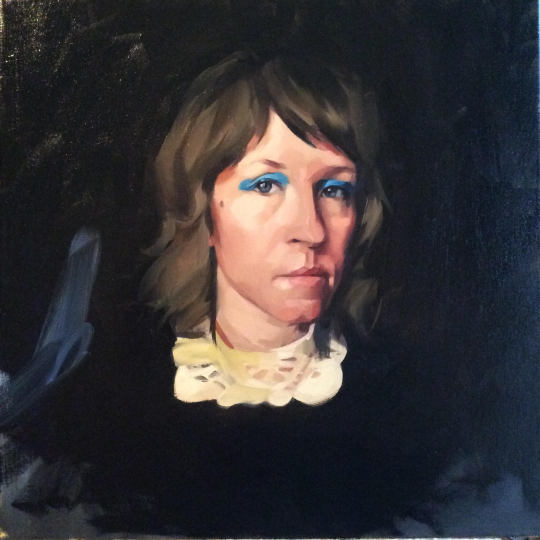
'Dutch Self Portrait' 2021 Robin Danely
Becky Paton, a mosaic artist, was also inspired by the ‘Young Rembrandt’ exhibition to examine the connection between her practice and self-portraiture and to determine the sources of inspiration for her vivid glass and ceramic works. She acknowledges the significance of her desire to capture particular moments, or memories in her works, psychologically marking the importance of an occasion, the works functioning as a cornerstone for that stage of her career. For the ‘JONG/young’ exhibition Becky has made a large self-portrait, ‘The 7th Warrior’ 2021 echoing the jewel like qualities of the paintings of the master. It is one of a trio of self-portraits exhibited that represent her creative journey, as well as encapsulating within them personal memories and signs of her interest in the natural world.
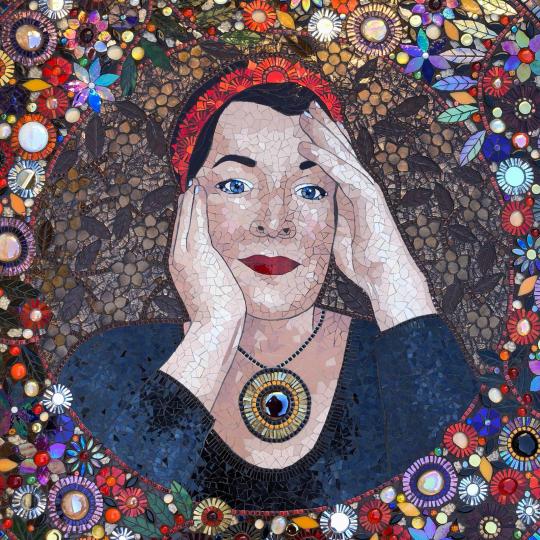
'The 7th Warrior, a self portrait' 2021 Becky Paton
The ‘Young Rembrandt’ exhibition revealed the importance of experimentation in shaping Rembrandt’s later practice, his earlier works showing his struggles with drawing and etching as well as his improvement and acquisition of skill in depicting the effect of light. Vicky Hirsch concluded that for her, the process of making is as important as the outcome, fuelling discovery and development. Taking time to pause and reflect helps artists to follow their intuition, essential for finding new sources of inspiration, and progressing artistic practice beyond mere reproduction. Vicky’s works for the ‘JONG/young’ exhibition are copper plate etchings, paying homage to the young Rembrandt’s dedication to the bettering of his own etching technique. Vicky documents the link between experimentation and artistic maturing, taking as a starting point a photograph of herself with the ceramic pots, also included in the exhibition, which she made as a younger artist. She has produced a series of etchings ‘My Younger Self I - V’ 2021 that act as a linear narrative of her own progress.
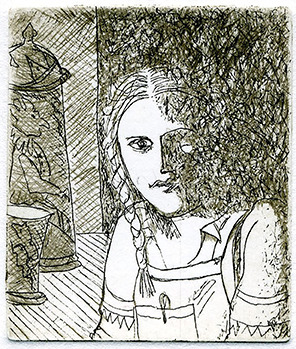
'My Younger Self V' 2021 Vicky Hirsch
Rembrandt’s early works show him exploring new and innovative subjects, bringing a reality and earthiness to his depictions of real women with sagging flesh rather than idealised forms. His honesty and determination to represent life in its rawest forms is also seen in works of peasants urinating and defecating, demonstrating that he chose not to shy away from the ordinariness of everyday life. Juliet Eccles powerful photographic and video works are similarly honest images of the experience of living with disability in all its ‘grubbiness’. She is interested in mortality and in how extended periods of illness have marked her. Her response to the works in the ‘Young Rembrandt’ exhibition echoes Rembrandt’s desire to show the fragility of life and human vulnerability. Her photographic works ‘Feed Me Now’, ‘Feeding Myself’, ’Nil By Mouth’ 2021, reference the act of feeding, stripping away the elegance of manners to show the primal struggle of achieving it for oneself and the discomfort of depending on others to help you. Her works, as Rembrandt’s do, communicate with us as living breathing human beings sustained by connection and our shared frailty.
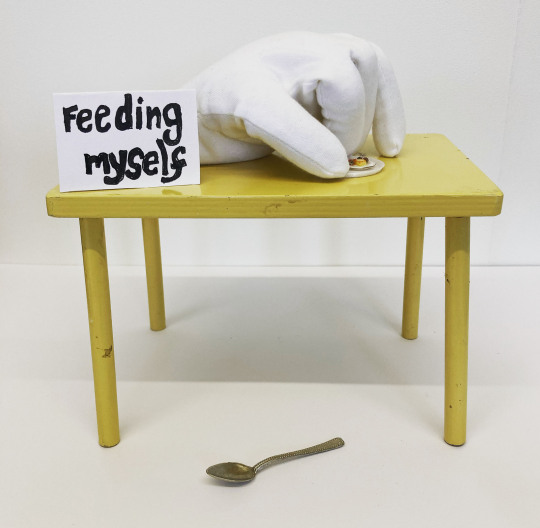
'Feeding Myself' 2021 Juliet Eccles
It is evident from the responses that the four exhibiting artists in the ‘JONG/young’ exhibition have made, that looking back and learning from the work of those who went before is as vital as self-reflection for an artist’s development. Both processes lead to greater understanding of creative inspiration and the source of the subjects which endure for them. Evident are signs of experimentation, improved technical skill, and the best representation of the ideas that pervade the work. The willingness to learn and to meet the challenges within artistic practice echoes the fearlessness of the young Rembrandt. Such courage and thoughtfulness can be usefully applied to life more broadly. We can perhaps all take inspiration from the themes of the ‘Young Rembrandt’ exhibition to learn the ‘art’ of reflection.
Clare Carswell and Hope Collinson
#artwriting#artistsoninstagram#rembrandt#ashmoleanmuseum#selfportrait#artanddisability#printmaking#ceramics
0 notes
Text
HOME BOOKS INTERVIEWS
HOPE COLLINSON in conversation with the four artists who made artists books during lockdown and showed them in the HOME BOOKS exhibition in May 2021. The four artists were brought together during the third Covid-19 lockdown, 2021, as participants of the online course ‘Root-Home’, a CREiA::: Creative Attentive Studio for mindful art practice. msdm.org.uk/creia
These CREiA workshops were piloted during the first lockdown in 2020, with a focus on combining deep listening and creative exercises inspired by mindful art practice and relational domestic crafts. Through shared engagement together and combining the domestic space of confinement with the practice of book-making, the artists developed their practices and created books based on the theme of home. Some of these were shown in the exhibition HomeBooks.
In these interviews, Hope asks the artists about how they have translated their practice into books...
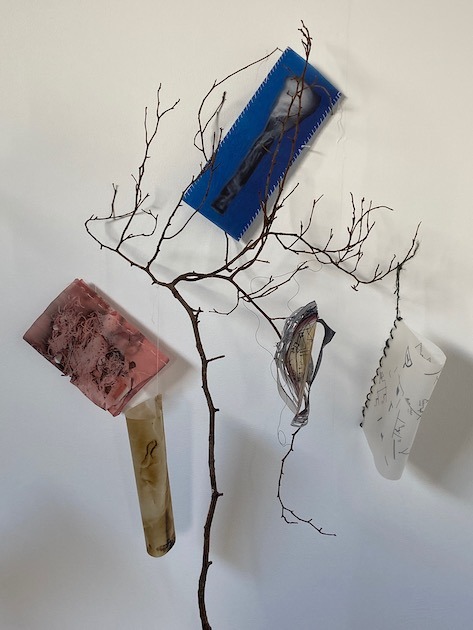
Rhiannon Evans Loose Leaves 2021
RHIANNON EVANS
Rhiannon Evans is an artist based in North Oxfordshire with a dynamic practice based on interventions and performance and rooted in community engagement. She is interested in how personal and collective experiences are recorded and transmitted. Her most recent work explores extended associations with the structures and systems of archival narrative.
How does the value of your personal archive inspire your books?
It isn’t so much the value of the personal archive but the nature of it. The way it moves unconsciously in and out, through present thinking and making and jumps onto, into and around other topics in a seemingly random yet connected way
"the books are more like a conversational story-telling"
In what ways does the idea of translating experiences through books and stories influence the books ?
The books I think are more like a conversational story-telling rather than something scripted. And unlike one book with sequential pages and a single narrative, there is more of a sense of a room with stacks of books, ordered according to the theme of the story at the time. Very non-linear unlike an ordered library. A sort of hypertext system to dip into with a variety of outcomes contingent on what is ‘leading' at the time.The ‘pages' are reformed, reordered and linked differently with every ‘re-telling or re-reading depending on the external and internal context of the ‘conversations’/ relationships. A sort of visual intertextuality....?
How did you link the idea of nature to books through folios?
I had been looking at bookmaking, folding, pamphlets etc and also thinking about printing and paper size etc especially during discussions during catalogue making.I noticed the language - like leaves for pages, folios for books or pamphlets made of paper etc and thought of how these are related to the natural forms of the leaf. Plus the relationship of archives and folios and the content of the work I had made/ was making.I have a botany professional practice background and many of the ‘pages’ of the work used altered botanical images which I made during the ‘Dwell Residency’!When working with CREiA I began to see a way of presenting works as a series of Folios rather than a set of images and duplicated editions.Whilst installing and sitting in the space with the work, the ‘leaves' occasionally fell ... Real leaves fall, decompose, and are then reabsorbed by the tree and other plants nearby incorporated and form new branches and leaves.
"the dead archive resurrected"
So inadvertently unconsciously it has a further fit - to a form of continuity and 'animated preservation’ - the ‘ dead archive’ resurrected .... Gosh this all sound rather pious and I don’t mean it like that at all. Like the printed images themselves, I hope there is a feeling of ‘inorganic’ systems and technology and ‘organic ‘ living structures being intertwined - biotechnology which has always existed...
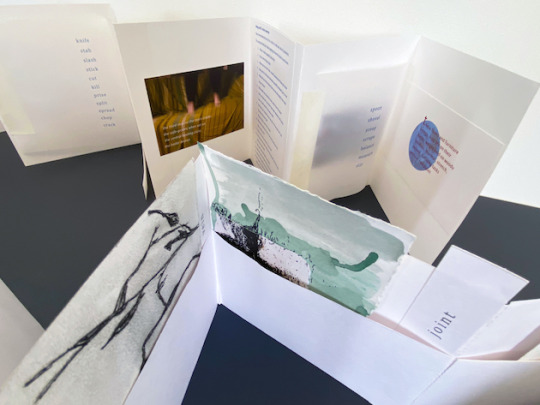
Annie Rapstoff Furniture Undertones 2021
ANNIE RAPSTOFF
Annie Rapstoff is a cross-disciplinary artist, interested in the interrelationship with ideas concerning place, the land and the human experience. Work may take the form of instructions, events, performance for the camera and in situ, gestures, interventions, video and writing/language. She tries to pay attention to what she hears, what she feels and what she experiences in space, through objects and across time.
Annie, how did you translate performance to books?
Performance work is transient and books offer material evidence, documentation and research possibilities. Book works have allowed me to excavate my archive of work and rework pieces and see them in a different light during the pandemic.
Covid 19 has left performance work bereft of venues and indoor spaces from which to experiment and show work. So apart from working outside which has been something I have done for many years and continued at times through lockdown; book art has offered a way to develop work and showcase it. It has offered a means of developing a narrative through text alongside images.
I translated performance work to a book form by extending the parameters of the work to include text and stretch the thinking further. Performance practice became something I could add to and embellish such as the fabric used on a chair whilst jumping on it. The book form allowed me to have a more intimate relationship to my performance work and it offered a way of standing back and really listening and seeing the work without being in it in the present moment the addition of book art extends the form of the work I am offering.
"The book form allowed me to have a more intimate relationship to my performance work"
So did the lockdown period encourage artistic productivity for you?
Yes, the lock down has had a very positive impact on my practice. Perhaps I respond well to confinement, or the taking away of responsibilities and commitments which take my time and focus away from my practice. Most of these demands were taken off me and I think I was ready for a new project.
Before the lockdown, I had experienced some health concerns and I had for some time lost my focus and energy. Then during the lock down a colleague began making a film on a first experience we had during the lockdown, my first was making masks and during this time I was reading a book by Daniel Defoe on the plague. The book mentioned the clothing and experience of the so-called plague doctor. A beak-shaped mask was used as protection. It was packed with herbs that were said to offer protection from the stench and disease of the plague. This greatly influenced the ongoing project I have conceived concerning birds and mask-wearing. I enjoyed the opportunity to make books during Creia workshops. Which offered the space for my work to be shown and given space rather than remaining in my head or sketch book undeveloped.
I have never seen myself as a maker, at art school I tended to focus on performance, text socially engaged work, film and photography. Making was something others did with their hands and I had an idea in my head that this just wasn’t part of my area of practice. However, since the lockdown, I have re-evaluated my work and seen that I have been making it even before this time. I was involved in working with found pigment on fabric and more recently I have been books putting images together in digital collage or overlaying images, areas I now see as important and that I should value more.
Do you feel that putting your practice into a different area something that you feel will be a lasting change to your art?
I think book arts will be an area of my practice that I keep developing, the reason being that it provides a container for ideas but more than that it extends ideas. I don’t think I will ever give up making performance-based work and it will always be essential to my practice, however book art has added a mutually compatible skill and enhances my work.
"book arts.... provides a container for ideas"
By making books I am empowering my practice through the authorship of binding and making, the act of making to me is as performative as many other actions I carry out and the viewer is complicit in the embodied action of entering the book and turning the pages. As an artist I have never seen myself as very skilled in any one medium and neither do I want to be dictated by one medium, but the knowledge of making an object has since the pandemic been fulfilling and rewarding and a means of communicating in an object form.
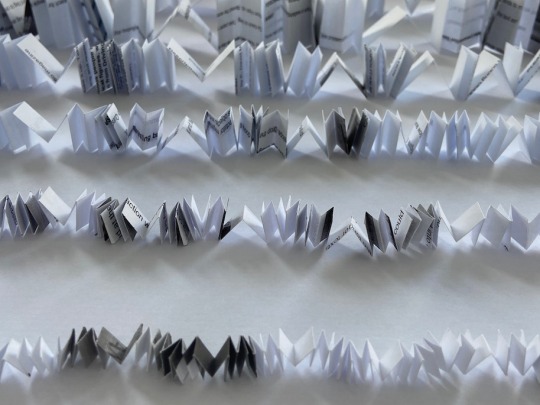
Peta Lloyd The Weeks rush by as the Hours linger 2021
PETA LLOYD
In 2020, during Lockdown, Peta completed her PhD, Text+Object+Action =Textact, which investigated if and how written text can work as the main focus of performative art practice. Having spent a long period designing and performing works with a clearly defined starting point, Peta is keen to use her DWELL time to explore different ways of working, both through performance and other media."The current inability to mix and work in the public realm has focussed my attention onto the making of short and simple works performed to the camera and resurrected her interest in printing, paper making and book-works."
Peta, did you feel limited through the constraints of performance to camera?
I felt performing live and performing to the camera were two very different activities. I enjoyed performing to the camera as: I could shoot the film deciding what the audience saw and did not see within the work. I enjoyed filming parts of the body and not having the whole body on view. Providing the materials allowed, I could shoot work multiple times until I was satisfied with the piece. It was easy to focus the camera on a small activity which would have had little impact if carried out live.
Did creating without a specific purpose in mind change your approach to your practice?
My work has always seemed to be process led rather than following a particular theme of interest. However, freedom to work with any materials and on any passing idea was liberating. I was able to try out new techniques and visit old skills used in previous works.
"using fine motor skills to fold and cut"
With regards to trying out new techniques - was beginning to work smaller a big change to your practice?
I found working small quite freeing as making, moving and manipulating is not as physically difficult. With the A4 sheet books, I was interested in how small and how many pages I could get into a book. It was interesting using fine motor skills to fold and cut eventually minute pieces of paper. Although repetitive and time-consuming it was a relaxing and enjoyable task.
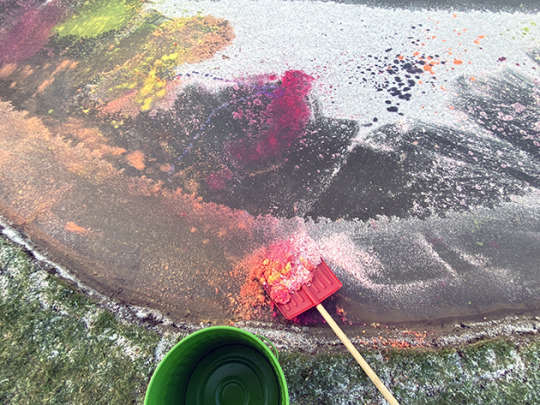
Clare Carswell Still from ARENA 2021 performance to camera
Clare Carswell works with performance, drawing and installation to make works for the gallery or the public space.
In works such as SMILE KEEP SMILING, DESSERT & SUGAR SUGAR, that exist somewhere between public health warnings and faux burlesque, Clare examines the trials , and the comedy, of maintaining an ageing body. She reveals some of the adaptations that need to be made in order to inhabit it well and the necessity of celebrating its power and beauty by transforming physical or emotional sites of pain into moments of joy.
Recent works find Clare making artists' books such as LAUNCH and WINGZING during the Covid-19 lockdown as she worked at home making private performances to camera in nature and the domestic space. These works come from a more reflective and meditative practice that leads to felt sense images that are vibrant, energetic and spontaneous. They celebrate the creative impulse as life force and identification with a chosen place as home.
Clare, you say that your books act as a portal to the performance works, how does this happen?
The books shown in the Home Books exhibition are proposed as portals to solitary performance works made to camera during lockdown. The inclusion in them of photographs of the live works or of a QR code linking to online videos of the work offers an experience of the work, but one that falls into the category of documentation.
The ephemeral nature of performance art is what draws me to it as an artist. Being present has previously been essential to experience my performance work, and as I don’t repeat my works there has only ever been one opportunity to do so. Documentation has been critical in order to disseminate my work beyond the attention span of the audience.
The works I made during lockdown have stemmed from an emerging embodied practice and been physically immersed in nature. Where an audience could not be present, then it felt more pressing to enable a corporeal experience of the work rather than just the digital. The performance works are embodied within handmade books that a viewer can handle and connect directly to my experience of making the work. They propose an active participation and another being present.
LAUNCH 2021, a flower fold photo book, takes on an additional aspect of prop as it uses two of the painted paper water lilies that were floated on a pond in the performance. I decided to use them to form the cover for the book, offering physical engagement with actual objects used in the work. This decision determined the ultimate format of the book as a lotus flower fold.
WINGZI 2020, is made as a folded book form, a seven section dos-à-dos, that I wore for the staged performance to camera and so the book embodies the performance and the performance the book.
The handmade book is offering me new possibilities for creating extensions to performance works that are more than documentation, but take their place as vital adjunct or completion of the work. I am now taking this further by designing performance works within which I act as living lectern, sharing the books with an audience. I am integrating my body visually within the books by the use of applied drawing and the making of props that become the books.
It is possible to challenge the meaning of being present and to connect with an audience via online platforms such as Zoom which I am now using when sharing the books.
"the book is offering me new possibilities for creating extensions to performance works"
How did you adjust to the differences that come with performing to a camera rather than to an audience?
Performing to camera is something I have done many times and when done alone it does mean that there is less distraction, an increased absorption in the work as well as control of it. VOTEM, made in a hotel room and FUEL, in my studio, both made in 2010 allowed heightened emotional experiences to be played out and documented.
The conflation of performance and photography is a strategy that I have also employed when making performance work with an audience. The introduction of a camera in the work makes explicit the temporal nature of the work, our varying positions within it and the futility of attempting to capture it. I will use the camera to photograph the audience and so take charge during the performance of the documentation of the work as in YOURS 2007. It is a means of drawing audience into the work as willing participant and I will often break off in the performance to hold a conversation with audience in which I explain what I am doing with the camera. The camera makes me behave differently and the audience too, who have I invited to exchange pictures of ourselves TAGS 2007, GIFTEN 2006, or to share a picture of us both as a selfie PURE JOY and KEEPER both in 2017.
The imposed solitude of lockdown meant another new behaviour as the camera became both a tool and sole witness to the works. The works were fleeting and disappearing before my eyes as wind blew or ice melted and so one hand was holding a camera even as I was activating objects with the other.
I am welcoming a shift into a phase of work that welcomes stillness, deeper listening and intuitive response to the environment and the natural world. They are solitary works for now and if the audience is to be invited again to witness them then I expect distance will need to be built into the works. Making the work and broadcasting it live online may achieve this.
I foresee the presence of witnesses as only one point of contact with my work and the camera as a vital partner so that the photographic, or filmed, as well as the drawn and constructed traces of it are equally relevant experiences of my work.
How did you incorporate this intuitive response to the natural world within your work?
The restrictions of the first lockdown meant that I could not make the journey by car to my studio to work there. I set up a temporary studio at home home on the dining table. This was workable as long as I restricted what I made to works no bigger than an A2 drawing board that could be removed in order for meals to be eaten. The weather that spring was warm and sunny which helped cope with the confinement and meant that increasingly life was spent in the garden and I began to perceive it as a site for performance work. I allowed the site to inform the content, the making processes that I brought to it and the form of the work.
The life we have been forced to live during the pandemic was alien then but feels more routine now. In those early days of Covid-19 I wanted to make work that referenced the frightening and overwhelming collective experience, to try to understand it by proposing it as subject for art making. I adopted the language of the pandemic by measuring out two metre strips on the lawn with painted rope within which to make socially distanced drawings and actions. At first this meant placing drawings or objects with nature acting simply as a backdrop. Daily walks in nearby woods led to work where I changed nature by hand-painting cow parsley and used my breath to blow bubbles above it in a series of playful and optimistic actions in a solitary performance to camera.
"I adopted the language of the pandemic"
As well as drawing and moving within the nature around me, I collected dead flowers and made works seemingly attempting to revive them with water or light, or tucked them into bed as though they were patients.
I began to observe closely the changes made to the domestic space by sunlight penetrating the house, especially late in the afternoon when low sunlight passing through the prism of glass objects on sills refracted the light into colour bands. I started to make still life works to include the refracted light and timed the tableaux to be photographed within the few moments that the sun passed through the glass. This led to drawings and table top performance works timed for photography in the same way.
Preoccupations with the natural world as site for performance were challenged by a house move made during the summer of 2020 and the arrival in a new home with an unfamiliar garden. The site was empty for me of histories and I began to work in a state of arrival, of alertness, in a more embodied way. Deep Listening practice led to the emergence of energised and spontaneous images placed in nature and harnessing the elements, wind, ice, water as active in the work. Works made in the cold months of the past winter lockdown, LAUNCH 2021 and ARENA 2021 are examples, scraping frozen paint off a pond so that it was left clean.
The ethos of nothing remains is critical and the works are removed or wash into the land or water naturally. In so doing a collaboration between the sentient and non sentient is honoured.
All writing is copyright the artists and Hope Collinson and cannot be reproduced without their permission.
#art writing#artistsoninstagram#womenartists#contemporaryart#performanceart#artistscollaborate#thisisliveart#feminism#artoftheday#drawing#books#artist books
0 notes
Text
HOME SAFE HOME
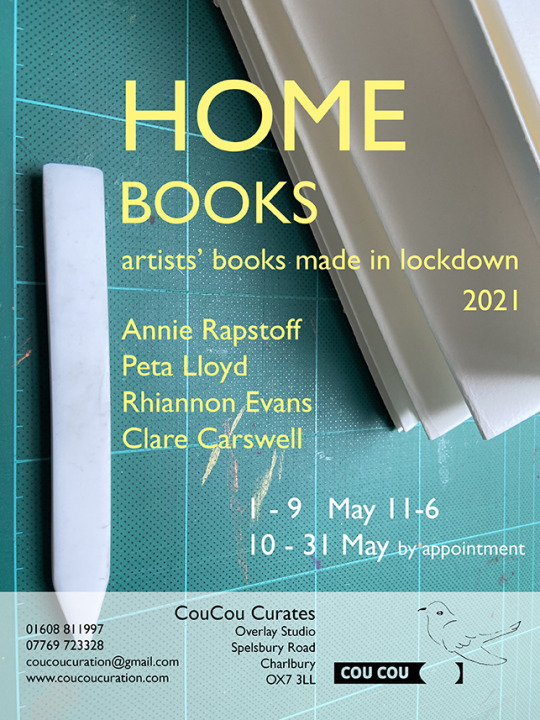
HOME BOOKS CATALOGUE ESSAY BY HOPE COLLINSON
Bringing five artists together to show books made through solitary artistic practice at home during the Covid -19 lockdowns, the CouCou Home Books exhibition demonstrates the resourcefulness of the artists in utilising the confined domestic space for creative production. The imposed restrictions were unwelcome and meant that the artists shifted their focus into the safe home space around them. This led to a forced introspection of the familiar leading to inspiration and adaptation, as well as compromise.
Conversation with the artists, from the perspective of an art writer, reveals that preoccupation with ‘home’ became a common theme for all, as the constraints of the lockdowns affected almost every aspect of the creative process. Another important theme that emerged was the re-assessing and re-presenting of work from their professional archives in new ways.
Rhiannon Evans uses her books as a way to ‘translate’ previous works, linking to other projects she has participated in. She deconstructs the idea of the book, stripping it back to the bare form of the folio and through its presentation maintains the freedom to reorganise differing aspects of it, so bringing a transient structure to archived works.
Annie Rapstoff drew inspiration from the sounds of chairs and tables in her home, marking a transition from looking for inspiration from the outside to deep listening to the inner. Creating books offers her a way of manifesting her practice in tangible objects, as representations of her art finding new directions.
Clare Carswell felt a deeper involvement with her home environment, incorporating sunlight through windows and objects such as dinner plates, mops and bedding into her photographic works. She took the concept of the studio out into her garden and the surrounding nature to make performance works for camera that harnessed the elements of wind, water and ice. Her books act as a portal to online records of those unique and private performative events.
Peta Lloyd used objects from within her personal environment in the creation of her books, as she made use of scrap paper from her PhD, finished in the first lockdown, as a principal material. Although it is usual for her to repurpose inexpensive and everyday materials in her work, the pandemic has brought about a transition to working smaller, focusing on the repetitive action of folding, that takes time to complete. These actions do not need a large space or studio, just a dining room table for getting lost in the practice itself.
A number of the artists drew attention to the welcome distraction of the time-consuming nature of creating the books. Art making and crafting at home can be a casual activity which does not require formality or intense concentration. It can be dipped in and out of, and smaller everyday pleasures can find themselves becoming part of the creative process. The pandemic has changed the way we perceive our home space as it has become a multi-purpose environment. For artists, the same is applicable to a studio space through its hasty and temporary relocation. This can both consciously and subconsciously infringe on privacy, as what may be a quiet studio space during the day needs to become a dining space in the evening. Lockdown has introduced the idea of the studio as an ever-changing space, that is flexible according to the needs of the artist and perhaps their cohabitees. It is clearer than ever that there is no ‘right’ way to practice art at home.
Despite the pandemic driving us physically apart, technology is bringing us closer together, and the importance of communication with others as part of the creative process has become pertinent for these artists throughout the solitary period of the lockdowns. Undeniably, lack of social interaction and physical sharing of spaces is one of the most noticeable impacts of the pandemic not just on artistic practice, but daily life in general. The regular online conversations between the artists provided a sense of community for them, creating a trusted space within which to share, discuss, and feedback on work. Brought together by the online CREiA course, this group of artists found focus and structure through their mutually supportive connection that has enabled growth in their work during the hardest of times, some of which is evidenced in the Home Books exhibition. As we configure our lives to be more compatible with technology, the virtual ‘new normal’ has allowed us to network with others, opening up the world by enabling global communities to form. This seems to be a new world where we are able to look outside of our usual networks and communities and extend connections further afield. All artists speak of the importance of such connection and the benefits of working with other artists to facilitate their creative process and provide a structure to their working week.
Shared project working towards deadlines invariably facilitates the processes of creating and completing work. At a time where artists are working at varying levels of ‘observable’ productivity, sharing practice with like-minded artists has motivated them while working through the constraints and challenges that lockdown presents. The dynamic conversations between the artists, at a time of great anxiety and isolation, is enabling new ways of working for all. The creation of these diverse artists’ books asks what ‘the book’ might be and offers varied and individual propositions to us.
The isolating experience of lockdown has been personal to each individual, and its impact on artists has affected the creative process through the relocation of studio space to the domestic realm, increased reliance on new technologies to sustain networks and changes to shared practice. In a pre-pandemic world, the practice of retreat, of sabbatical, and its benefits of solitude for research were embraced as a means of enabling focus and reflection. Part of the meaning that we have attached to lockdown lies in the linguistic signifier, and it is worth considering how our perceptions of this time would be changed if ‘lockdown’ was ‘respite’.
Hope Collinson www.hopecollinson.com
0 notes
Text
Art Pitch Artist Residencies

ART PITCH residencies offer artists, film makers, musicians and writers from the UK and abroad the opportunity to work at Overlay Studio in the peace of the lovely Cotswolds countryside near to Oxford and with easy access to London. Applications are welcome from professional practitioners, emerging and mid-career, or current students, who want time for their own research. Residencies can be of any length from one week to a month. Please refer to website for information on fees.
The Art Pitch residency programme is ideal for an arts practitioner who wants to take time out from their busy life and environment for a short period of quiet reflection and research. Residencies are supported but self-directed. Artists can be as solitary as they wish, although dialogue with other artists can be a valuable part of time spent at the studio and may lead to future collaborative outcomes. Works made during the residency can be exhibited in the project space by arrangement. It is well suited to anyone who enjoys spending time in nature. The Cotswolds landscape is beautiful and filled with ancient standing stones and sites of historic interest. The studio is in the Evenlode Valley and yet is within easy reach of Oxford - fifteen minutes away by train and just over an hour by train to London. Artists can stay on a small campsite beside the studio in a tent that is provided with all facilities. Wooden pods are available and plenty of Airbnb in the local area if preferred.
Please apply through the Art Pitch website www.artpitch.org
0 notes
Text
Meeting at a distance
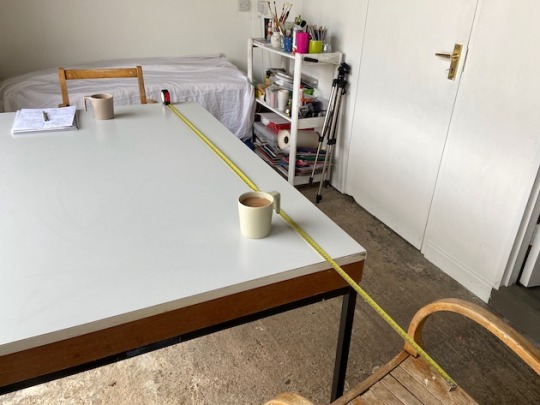
This week I had the first meeting with a colleague at my studio since early March. An artist who I am working with, we planned a get together for a socially distanced meet to chat over plans for an exhibition of her work later in the year. The large table in the project space fitted the bill to the inch and I flung open the barn doors so that the space was well ventilated. Table and chair were sanitised before she came and after she left; she arrived clutching a large bottle of hand sanitiser. A cup of tea was offered cautiously, we had agreed she would bring her own drink, but she had forgotten to do so. She had been so excited at the prospect of a real meeting after months of chatting online, that she also forgot to bring her portfolio of work to show me !
Mildly frustrating though that was, it reminded me of the brain freeze that I experienced on my first lockdown easing visit to a particularly swish lifestyle store at a large garden centre here in the Cotswolds. I spent half an hour strolling around savouring the experience of being there, commenting on the gorgeous but frankly unnecessary items, the novelty of the one way system, stickers on the floor and sales assistants in masks. As I got in the car to drive home I realised that I had forgotten to buy anything ! I had behaved as if the place were a museum or gallery rather than an emporium desperate for me to spend some money. What might feel normal, a trip to the shops or a meeting with a colleague, is most definitely not the normal that we knew. That may be no bad thing, nothing can be taken for granted as perhaps it once was, at least not for a while : we are seeing how human beings are remarkably forgetful of the need for caution once the threat appears to have lessened and restrictions eased. Clearly we all have to adjust how we behave in order to function and we will have to for a long time. In the meantime the ailing economy had better not rely on me to revitalise it !
0 notes
Text
Collaboration during lockdown

Collaboration with artist colleagues during lockdown has been vital and enjoyable, it has kept me working, cheerful and motivated. We have shared ideas and images and watched artist talks and online exhibitions together. We have posted pictures of our works in progress on social media and made plans for a time when we can be in the same space together to develop projects and hopefully to exhibit again.
One especially fruitful conversation has been with artist Ema Mano Epps. Based in London, Ema runs Platform 1 Gallery and we have collaborated on performative works since 2018. We have both been researching Flow theory and using meditation and other ways of taking ourselves into a zone where we are working in the moment and with energised focus.
Ema has found using free form poetry a way into her creativity whereas I have spent time in nature working with objects animated or changed by the elements. We are currently making collaborative works that embody these ideas and strategies. You can view two short videos we have made here :
www.vimeo.com/coucoucuration
www.emamanoepps.com
#artists#art#womenartists#artandnature#collaboratewithnature#meditation#lockdownart#covidart#workingathome
0 notes
Photo

Art Insights, Reviews, Interviews & Reflections on contemporary art practice by artist curator Clare Carswell with guest contributors.
1 note
·
View note
Text
Reaching out from the inside
The page of this blog has many pictures of my art activity over the long weeks of the Covid pandemic. As I scroll down it I see vibrant and imaginative visual works that I have made, and I feel pleased at how much I have been able to make when living through such a frightening and confusing time.

I have made many small works, drawn, photographed or performed to camera; because it is what I do, but also to distract myself and to maintain a state of productivity and of forward thinking when so much has been about stasis, fear, sickness and death. I have had low days when I have worried about the people I love getting ill and I have hated the restrictions we have and still do endure. I have worked hard to turn my thoughts to art and film and writing in order to keep myself engaged with my imagination - where I can make anything happen and I can feel in control when so much of my life now feels controlled by others who I increasingly do not trust or even believe.
At home, as many people have been, for weeks not going to my studio, art making has happened on a table, or in the garden or on local walks in nature well away from other human beings. The dining room has become my main studio with a temporary painting space set up between meals in the light and airy kitchen. I have worked outside in the garden that we are lucky to have, and have taken full advantage of the wonderful weather we enjoyed through April and May. I have made performance work in local woods, lugging bags of materials with me. I have made installations in flower beds and on the lawn. I have made videos working with the wind and staged photographs with sunlight. I have also made many paintings and drawings of flowers and of our garden, something I have done since I was a child and that takes me to a place of absorption and of serenity, I have really needed to feel both. I have never regarded this art, made purely for please, as part of my professional practice, I rarely show those pictures. Maybe the time is right to review that and try to integrate that aspect more.
My husband has not seen me working up close before and he has had to adjust to having a busy working artist in the middle of our home. Interested, if sometimes a little baffled by my activities, he has I think learned that ideas cannot always be explained as they are in the process of evolving and he goes with the flow now. Keen to help me he has taken the pictures I need for documentation as I make small action tableau and perform to camera. My intent on doing my work and the adjustments we have made at home to enable me to do so has helped us both to regard this awful time as one of productivity as much as paralysis and we are both grateful for that.
Now at the end of June and as lockdown eases, we are going out more and I can drive the few miles to my studio and work there if I choose to, I am alone there so it is a safe thing to do. The studio needed some care and attention having stood empty for so many months following an especially wet winter. Cobwebs festooned it, there was bird muck on surfaces where small nesting birds in the eaves of the old barn fly in to the project space and panic and poop before flying out again. Mildew on the walls needed scrubbing off. Now after a concerted effort to clear and clean it is a pleasure to be there again. It is a place where I can be with myself and breathe, be still and get in touch with my ideas and vision new works.
We have been lucky, we are together and we have survived this time well in a safe and beautiful place. Best of all we are still healthy. As I pack the car with the many bags and boxes to be relocated back to my studio I have many gleanings of ideas to take forward into the new version of normality that we find ourselves living in. I am excited but mostly I am very grateful.
0 notes
Photo
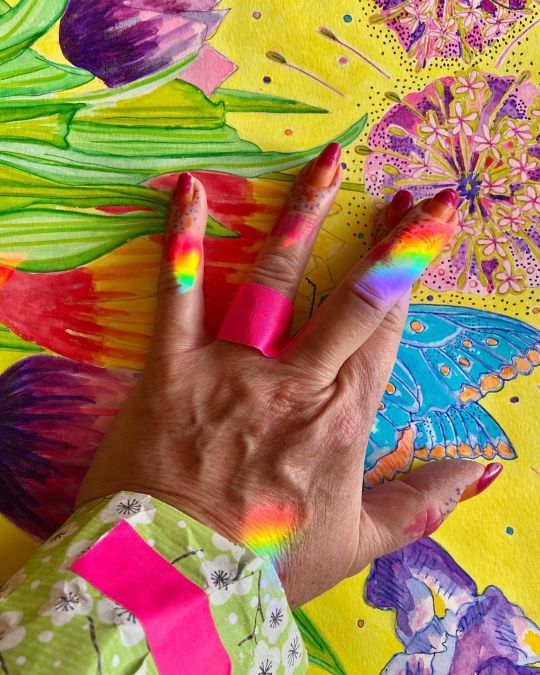
Hopeful #Covidart #lockdownart #colourtherapy #lighttherapy #busyfingers #workingathome #womenartists #artistsoninstagram #collaboratewithnature https://www.instagram.com/p/CBJgwJwloZX/?igshid=18fkll6omwli4
#covidart#lockdownart#colourtherapy#lighttherapy#busyfingers#workingathome#womenartists#artistsoninstagram#collaboratewithnature
0 notes
Photo
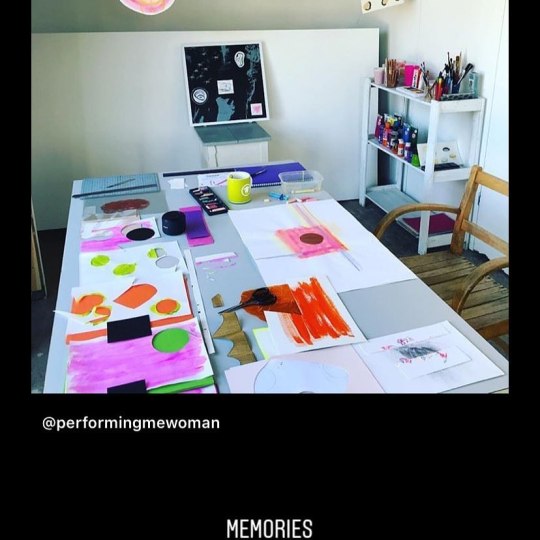
I start work back at my lovely studio tomorrow and I can’t wait. Working at home has been fine but I am missing my productive space and can now resume curation residency projects that had to be set aside. #artistsoninstagram #womenartists #backtowork #artistresidency (at Coucou ART Curate) https://www.instagram.com/p/CBAcX3CFvhM/?igshid=1nfpvdbirw0kg
0 notes
Photo
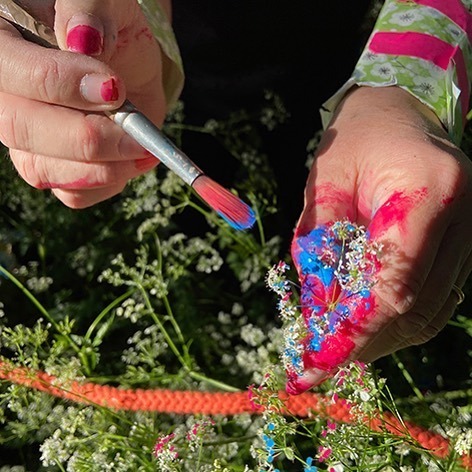
Bearer 2 #covidart #lockdownart #busyfingers #workingathome #womenartists #artistsoninstagram #collaboratewithnature (at Tetbury) https://www.instagram.com/p/CA3FrhClGr6/?igshid=14w11lg1o3mbp
#covidart#lockdownart#busyfingers#workingathome#womenartists#artistsoninstagram#collaboratewithnature
0 notes
Photo

Bearer 1 #covidart #lockdownart #busyfingers #workingathome #womenartists #artistsoninstagram (at Tetbury) https://www.instagram.com/p/CAdAeQSFDUI/?igshid=1i5esg3q8mbvx
0 notes
Photo

I am loving drawing flowers right now, as when I was six #lockdownart #covidart #artistsoninstagram #womenartists #worksinprogress #workingathome (at Tetbury) https://www.instagram.com/p/CAIk1MylnpW/?igshid=tutfhkmghui0
0 notes
Photo
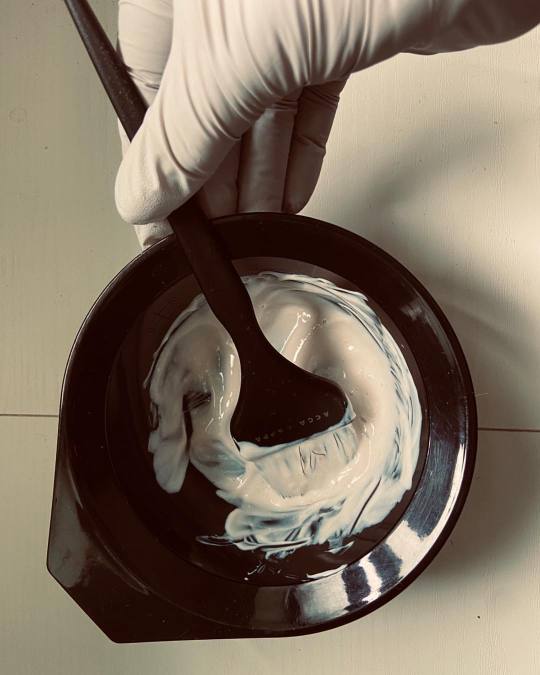
Colouring in #lockdown #covid #sistersdoingitforthemselves (at Tetbury) https://www.instagram.com/p/CAANsoflLmB/?igshid=1cbpfgki60cj2
0 notes